Home » 2021
Yearly Archives: 2021
Q4 2021 Newsletter
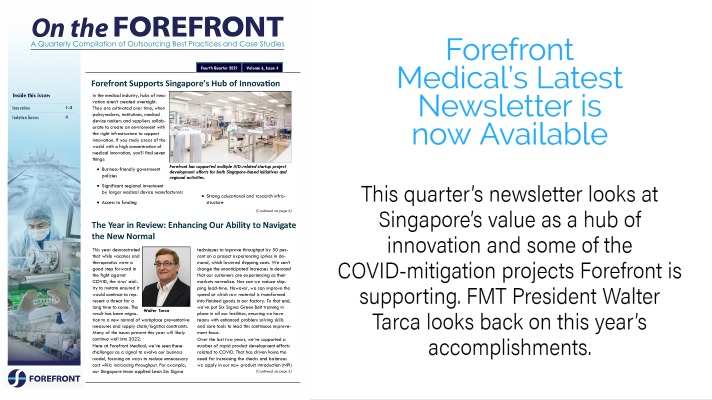
Forefront Medical’s On the Forefront newsletter focuses on innovation this quarter. Singapore’s infrastructure supporting medtech innovation is discussed along with several COVID-mitigation projects that Forefront’s Singapore team has supported. Forefront’s UK-based Arrow Medical subsidiary’s isolation gown products are also discussed. Forefront’s President Walter Tarca reviews some of the year’s key accomplishments in navigating the new normal. Read the full issue here.
Q3 2021 Newsletter
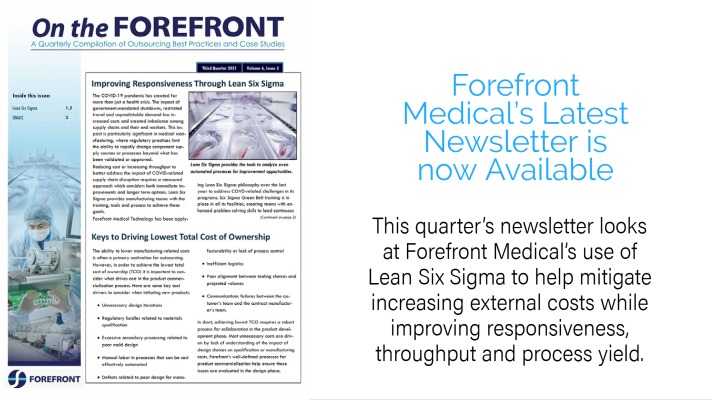
Forefront Medical’s Q3 2021 newsletter is now available. Read it here.
Improving Responsiveness in a Challenging Market

The COVID-19 pandemic has created far more than just a health crisis. The impact of government-mandated shutdowns, restricted travel and unpredictable demand has increased costs and created imbalance among supply chains and their end markets. This impact is particularly significant in medical manufacturing, where regulatory practices limit the ability to rapidly change component supply sources or processes beyond what has been validated or approved.
Reducing cost or increasing throughput to better address the impact of COVID-related supply chain disruption requires a measured approach which considers both immediate improvements and longer term options. Lean Six Sigma provides manufacturing teams with the training, tools and process to achieve these goals.
Forefront Medical Technology, a vertically-integrated specialty contract manufacturer with a focus in disposable diagnostic, drug delivery systems and medical device systems has been applying Lean Six Sigma philosophy over the last year to address COVD-related challenges in its programs. This whitepaper looks looks at its Lean Six Sigma continuous improvement process. Read the full whitepaper here.
Safe Launch Minimizes New Product Learning Curve
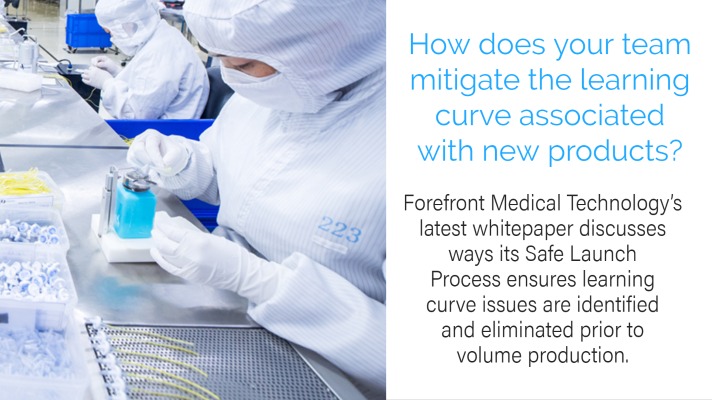
Outsourcing can bring many benefits: cost reduction, access to expertise not available in-house and reduction in working capital otherwise tied up in production resources. That said, when a medical device manufacturer outsources manufacturing, they are also outsourcing reputation. As a result, it is critical that the contract manufacturing partner take as diligent an approach to ensuring product quality as they would have the products been built in-house.
Extended team relationships can create communications issues. New product manufacturing always has a learning curve. These were some of the key issues the team at Forefront Medical Technology considered when developing its Safe Launch Process.
The process builds on existing quality processes and best practices, auditing both business elements and critical-to-quality (CTQ) areas to ensure that both quality and quantities shipped align with customer requirements. This whitepaper looks at the typical issues that can occur within a new product startup and ways that the Safe Launch process is designed to catch and correct those issues. Read the full whitepaper here.
Q2 2021 Newsletter
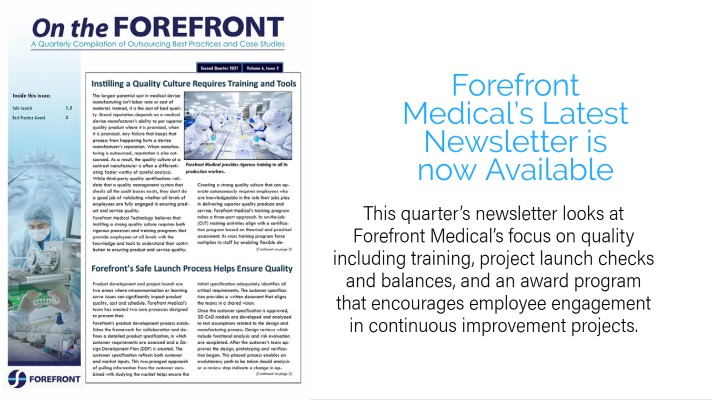
Forefront Medical’s Q2 2021 newsletter is now available. Read the full issue here.
A Contract Manufacturer’s Quality Culture Can Be A Differentiating Factor
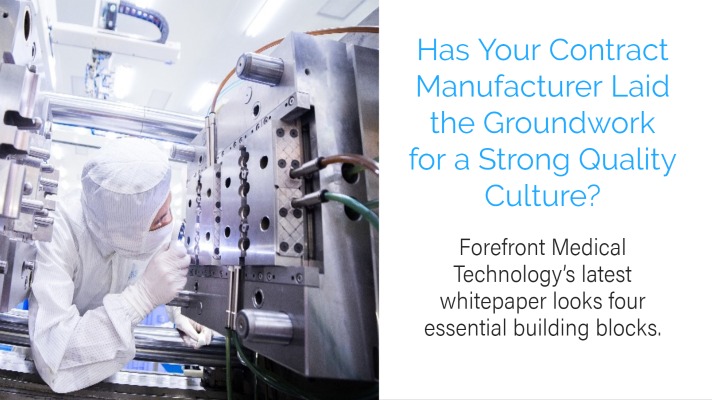
The largest potential cost in medical device manufacturing isn’t labor rate or cost of material. Instead, it is the cost of bad quality. Brand reputation depends on a medical device manufacturer’s ability to put superior quality product where it is promised, when it is promised. Any failure that keeps that process from happening hurts a device manufacturer’s reputation. When manufacturing is outsourced, reputation is also outsourced. As a result, the quality culture at a contract manufacturer is often a differentiating factor worthy of careful analysis. While third-party quality certifications validate that a quality management system that checks all the audit boxes exists, they don’t do a good job of validating whether all levels of employees are fully engaged in ensuring product and service quality.
Forefront Medical Technology believes that instilling a strong quality culture requires both rigorous processes and training programs that provide employees at all levels with the knowledge and tools to understand their contribution to ensuring product and service quality. This whitepaper looks at the building blocks for that level of engagement which include:
- A robust training program which gives employees the knowledge and tools to excel at their jobs
- Core quality disciplines that help eliminate defect opportunities
- Well-defined processes for product development and commercialization
- A Best Practice award program which rewards employees with continuous improvement suggestions.
Read the full whitepaper here.
Q1 2021 Newsletter
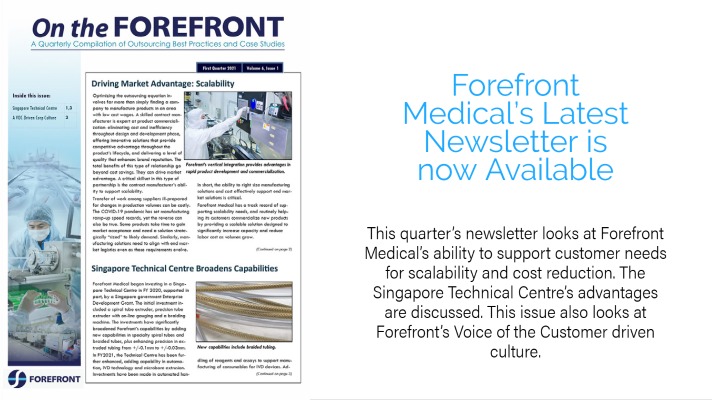
Forefront Medical’s Q1 2021 newsletter is now available. View the complete issue here.
Improving Speed and Automation Scalability

If there is one thing that is predictable in today’s medical device market, it is lack of predictability. The COVID-19 pandemic has changed demand for established products, created demand for new products and driven the need for re-evaluating optimum sourcing strategies. One thing that hasn’t changed are the benefits of working with a vertically integrated contract manufacturer, rather than multiple, specialized suppliers. A vertically integrated supplier offers a number of benefits including a broader range of manufacturing technology options, more control over the resources of production and a reduction in component markups. However, the two biggest advantages are speed and scalability.
In this whitepaper, Forefront Medical Technology, a vertically-integrated specialty contract manufacturer with a focus in disposable diagnostic, drug delivery systems and medical device systems, looks more closely at the benefits of vertical integration in reducing time to market and initial automation and/or tooling costs. Read the full whitepaper here.
Leveraging Contract Manufacturer Skills to Achieve Market Advantage
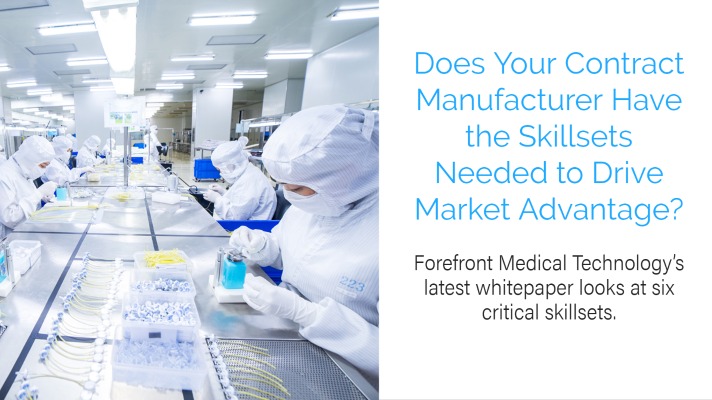
Optimizing the outsourcing equation involves far more than simply finding a company to manufacture products in an area with low cost wages. A skilled contract manufacturer is expert at product commercialization: eliminating cost and inefficiency throughout design and development phase, offering innovative solutions that provide competitive advantage throughout the product’s lifecycle, and delivering a level of quality that enhances brand reputation. The total benefits of this type of relationship go beyond cost savings. They can drive market advantage. The question becomes what skillsets indicate that a contract manufacturer is capable of achieving this level of partnership?
Forefront Medical Technology, a specialty contract manufacturer with a focus in disposable diagnostic, drug delivery systems and medical device systems, feels there are six critical skillsets that help drive market advantage:
- Scalability
- Cost savings
- Vertical integration
- Quality
- Technology expertise
- Speed.
This whitepaper looks at each of these skillsets and discusses how they contribute to specific areas of market advantage. Read the full whitepaper here.

